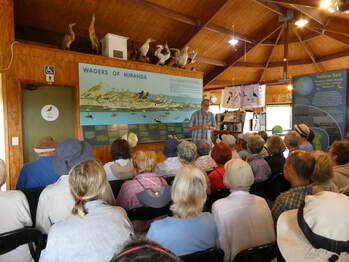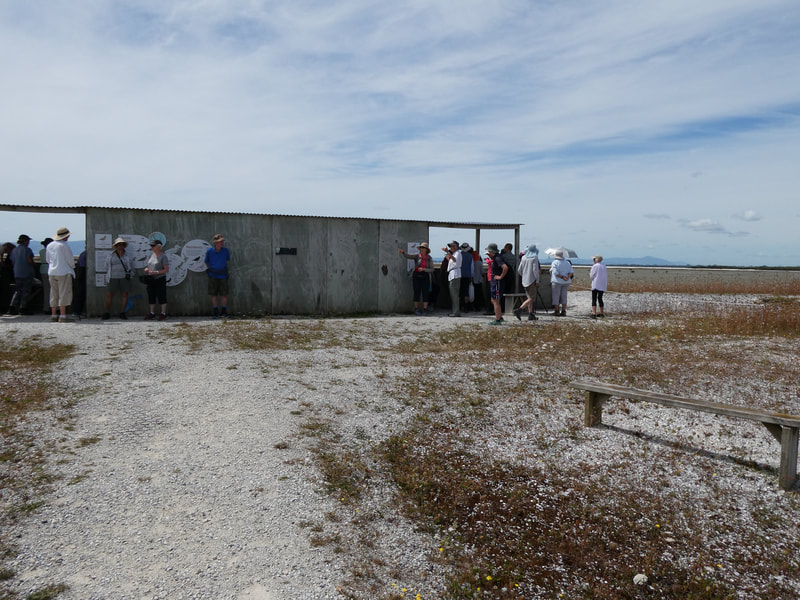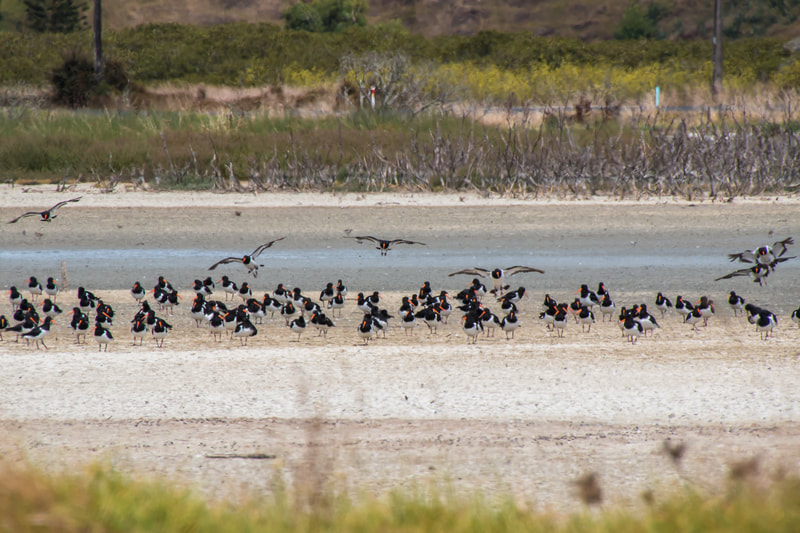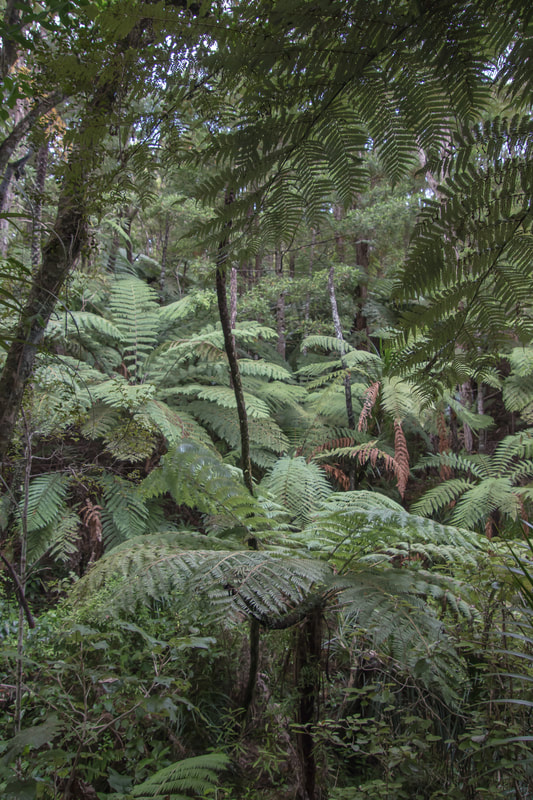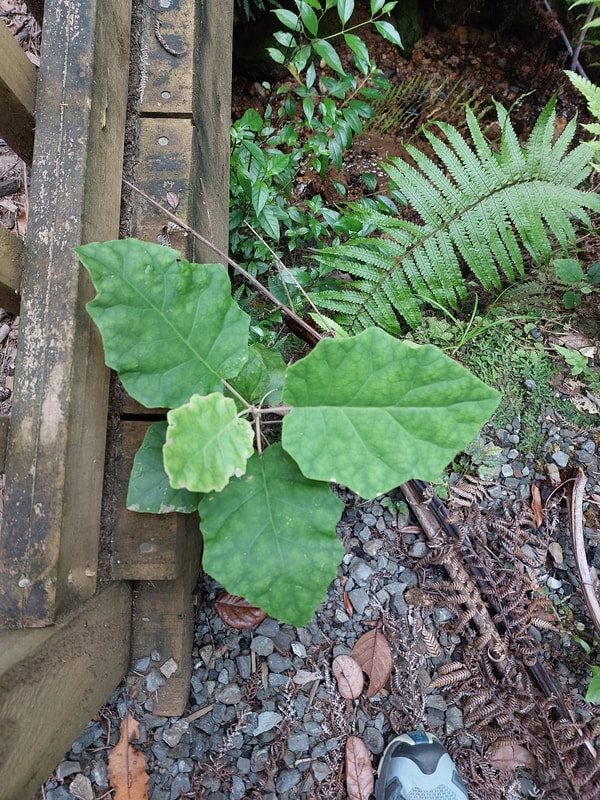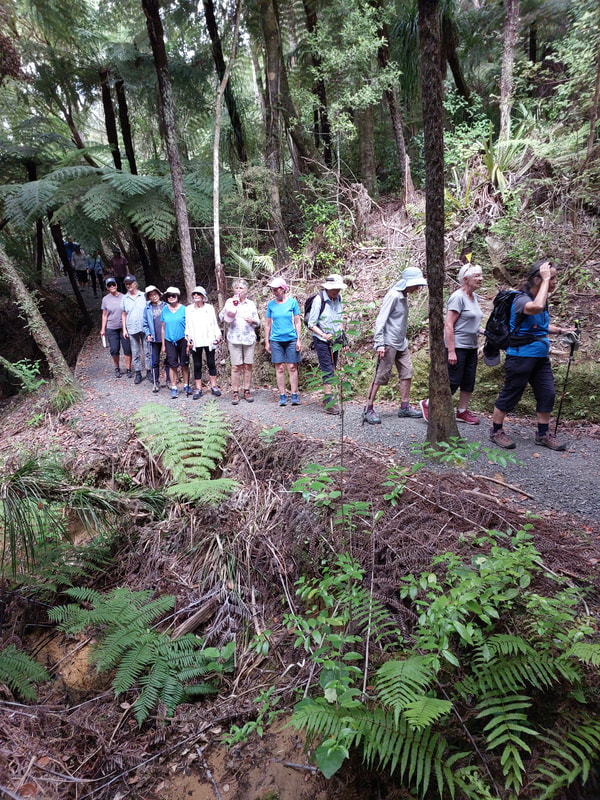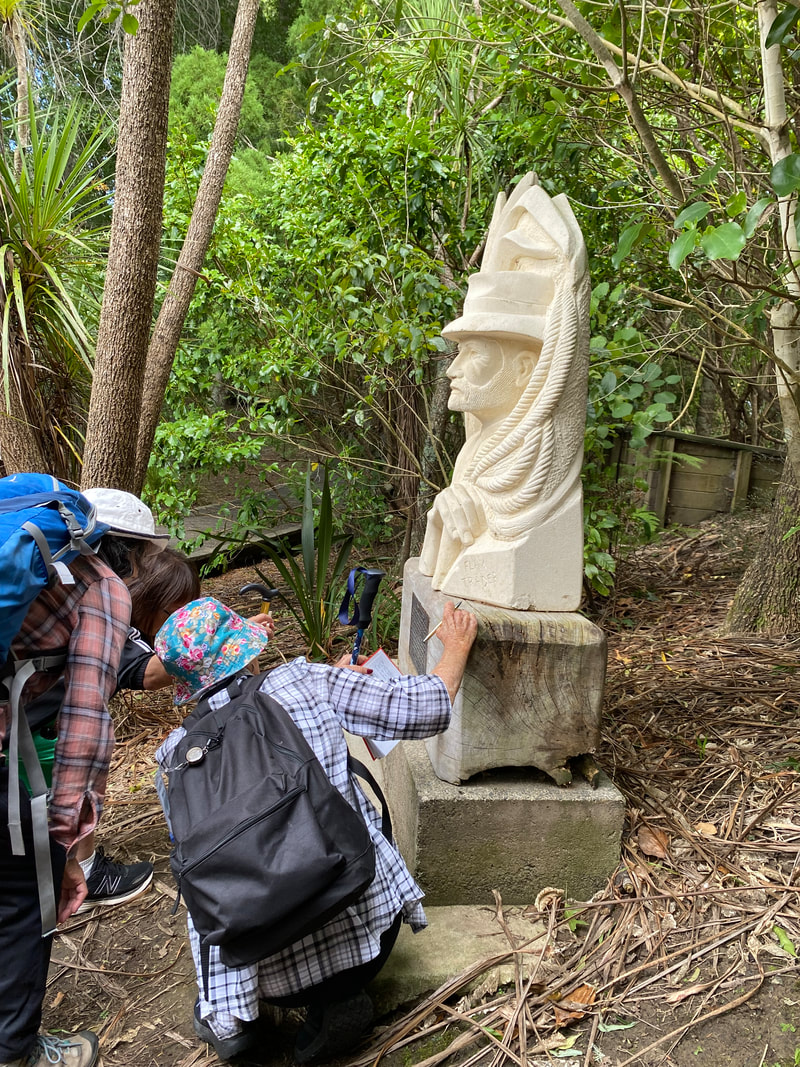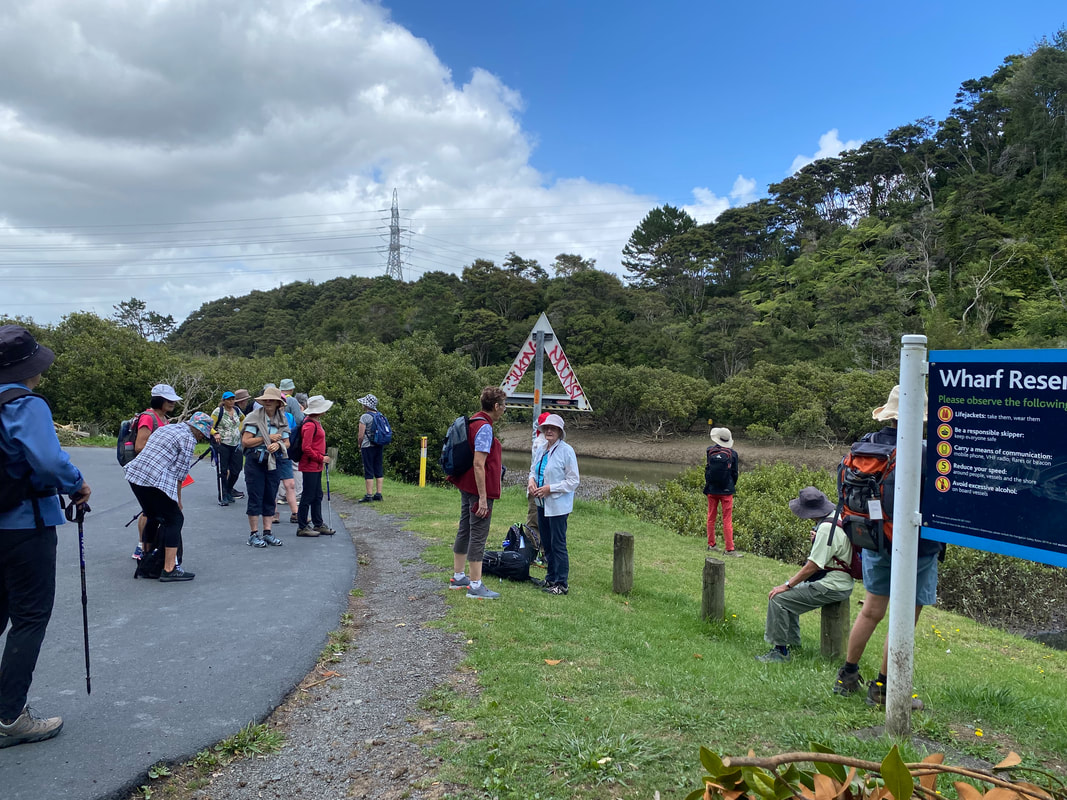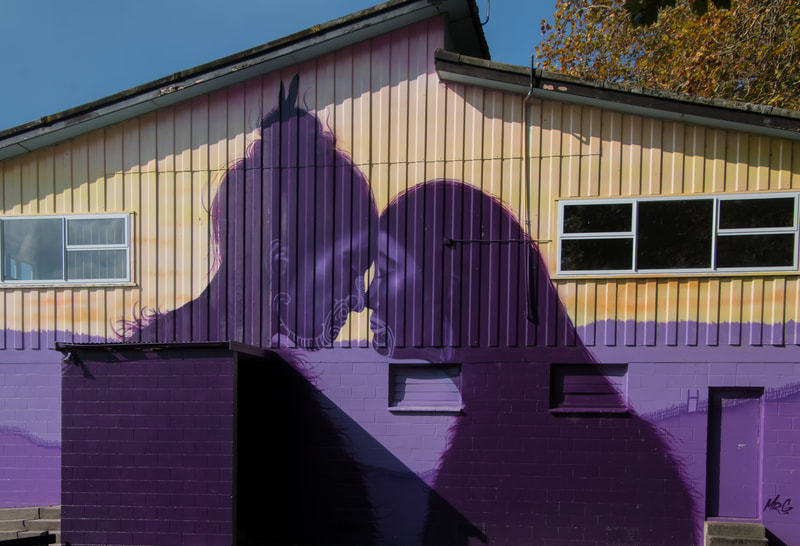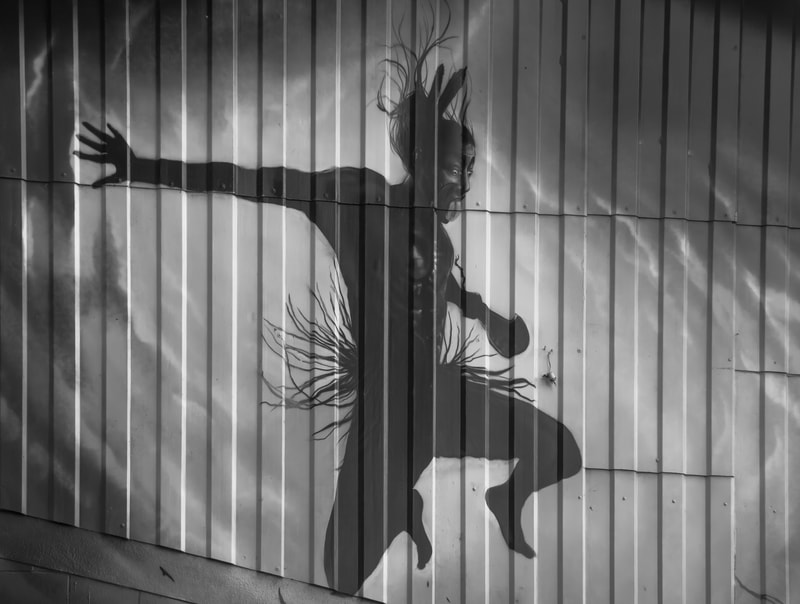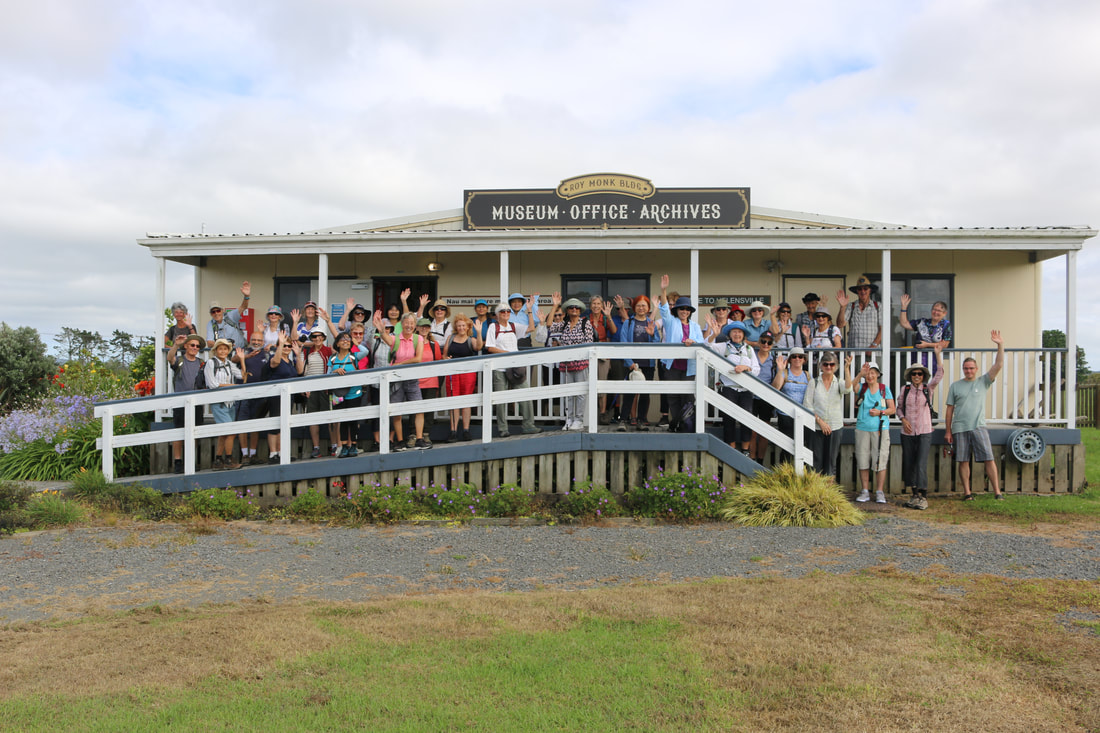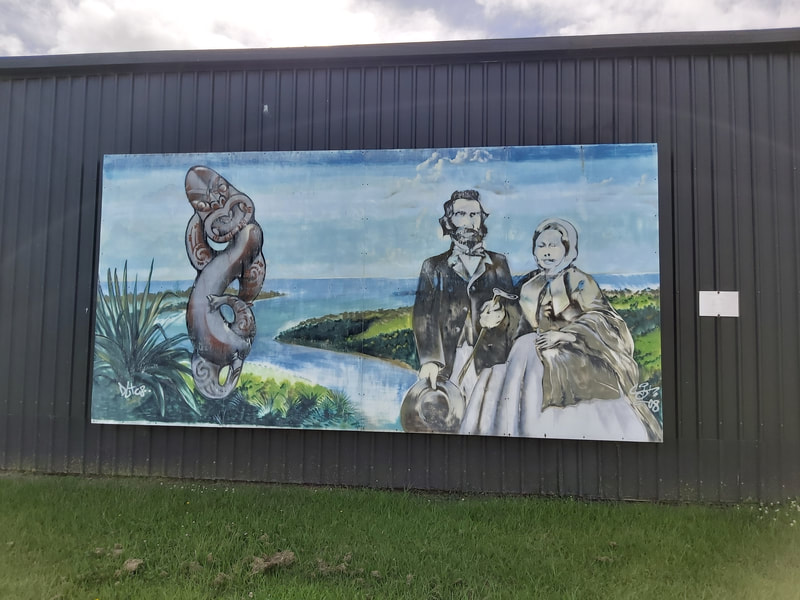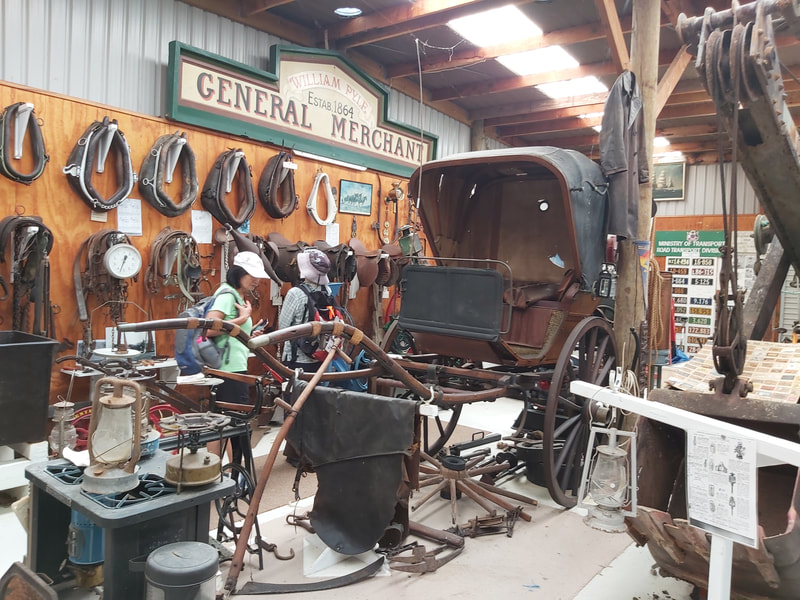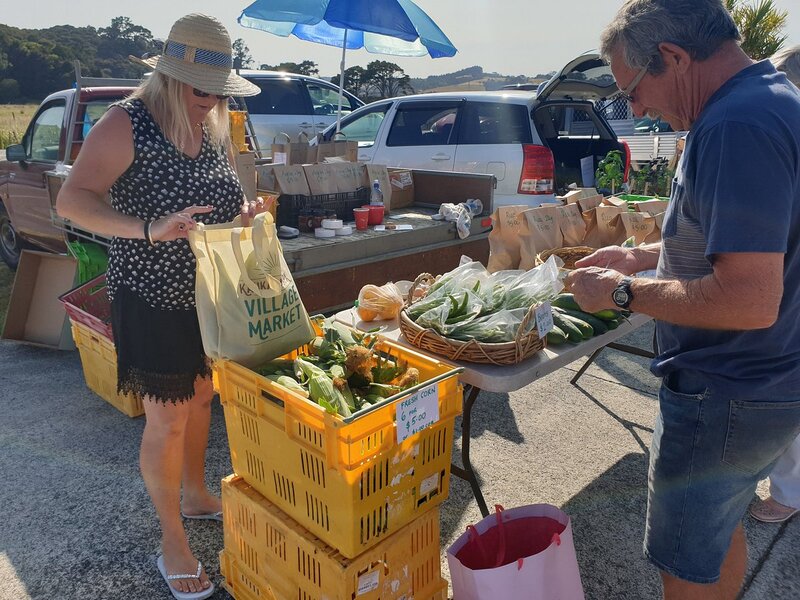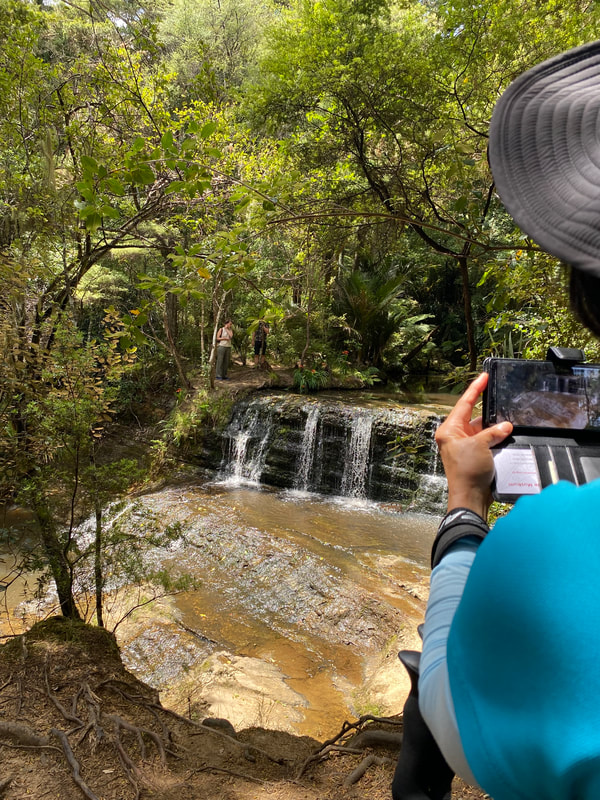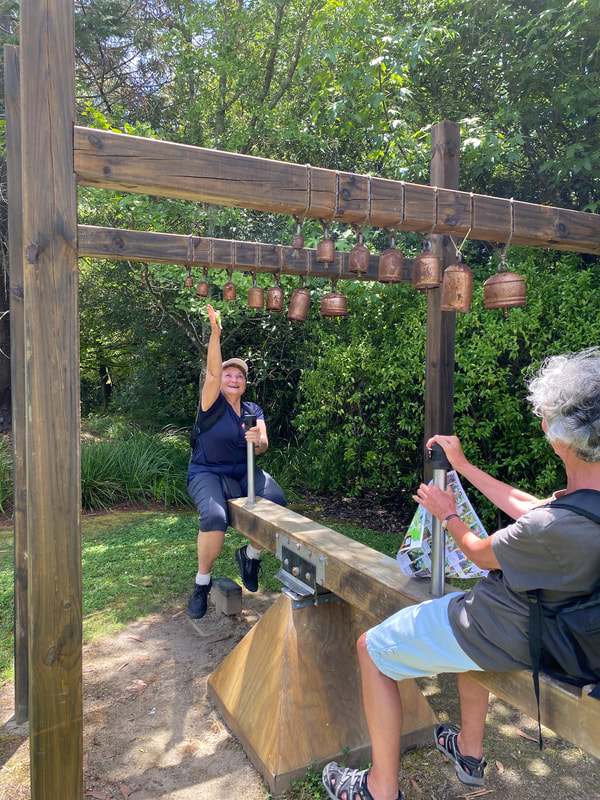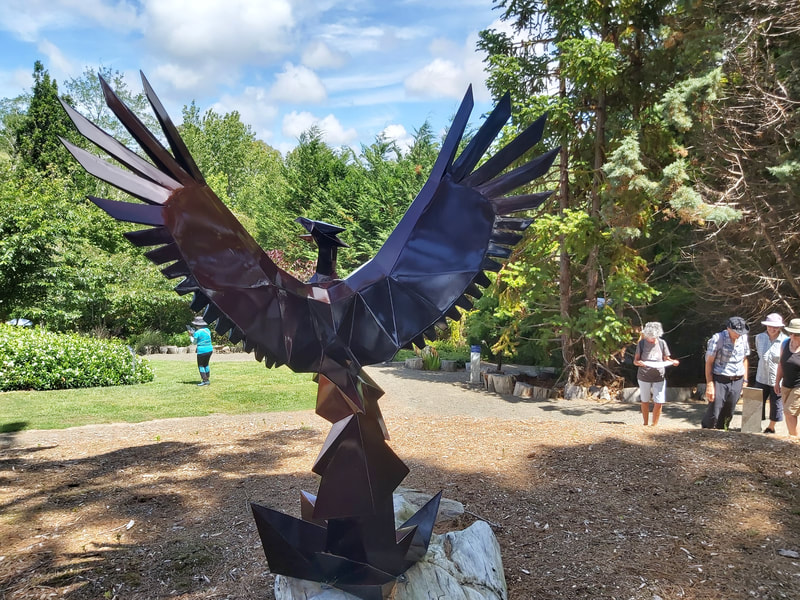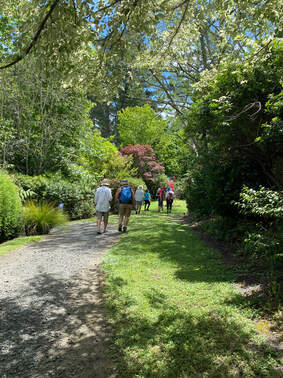Trip Reports: January - February 2024
18 February 2024 - Miranda Shorebird Centre and Waharau Regional Park
We were so lucky with the weather on our trip to the Shorebird Centre at Pukorokora/Miranda and the Waharau Regional Park.
After a stop at the BP station we travelled along Highway 2 through Mangatawhiri and followed the road until we came to the Miranda Road, before turning onto East Coast Road. This trip down to the Pukorokora/Miranda Shorebird Centre was a reminder of how wonderful our New Zealand countryside is.
On arrival at the Shorebird Centre, we were invited to partake in tea or coffee and have our morning tea. Many of us took the opportunity to browse through the shop which afforded us the opportunity of buying wonderful gifts or treasures to take home.
After a stop at the BP station we travelled along Highway 2 through Mangatawhiri and followed the road until we came to the Miranda Road, before turning onto East Coast Road. This trip down to the Pukorokora/Miranda Shorebird Centre was a reminder of how wonderful our New Zealand countryside is.
On arrival at the Shorebird Centre, we were invited to partake in tea or coffee and have our morning tea. Many of us took the opportunity to browse through the shop which afforded us the opportunity of buying wonderful gifts or treasures to take home.
|
We were then in for a treat. We were able to hear Keith Woodly (Manager of Pukorokoro/Miranda Shorebird Centre) talk about the lives of the shorebirds on the Thames Estuary. We heard about the research that the Centre and Keith are involved in and the lives of two godwits; E7 and E5 (and I thought I had strange names for my animals).
It must be acknowledged that Keith is a Member of the New Zealand Order of Merit (2022), an author and champion of shore birds in New Zealand. He also has a wicked sense of humour and enthralled us all with words and knowledge. |
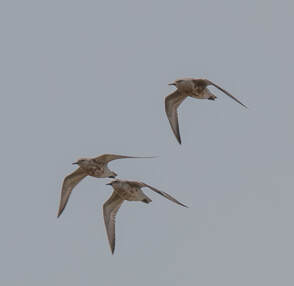 Wrybills in flight.
Wrybills in flight.
Volunteers from the Centre escorted us down to the Robert Findlay Wildlife Reserve where we were able to visit three hides and view the birds.
One of the highlights was being able to watch the flocks of South Island pied oyster catchers, spoonbills and wrybills flying into feed on the mudflats.
This group of volunteers were willing to share their knowledge and understanding of the birds and captured our imagination.
The coast plain of the area comprises almost entirely of old shell ridges and is a flat landscape of paddocks and salt marsh with a view of the Coromandel Range beyond. As we drove up to Waharau Regional Park where we were able to have lunch, we could see many flocks of oyster catchers and the occasional white-faced heron. Our environment changed from very coastal to the most beautiful bush as we started our walks along the Waharau Lower Link Track Loop, with the A walking group completing the track in its entirety and the B walking group walking part of the loop before meeting the A group and returning to the beginning. We were able to see the regenerating kanuka that dominated the lower slopes, mixed fern and kauri and a variety of club mosses, filmy ferns, liverwort, and coral lichens,
Waharau means ‘the ever-changing stream mouth’ and Waharua Regional Park is the eastern link to the Hunua Ranges
 Kawakawa Bay - ice cream stop.
Kawakawa Bay - ice cream stop.
A day of contrasts, the sea with the sun and birds and then the lush regenerating bush with amazing tree ferns, mosses, an earthy smell and amazing bird call.
We returned to the bus for a seaside drive up the coast to Kawakawa Bay where we treated ourselves to ice creams and a stroll along the beach before heading back into Auckland.
Special thanks to Anne and Robyn for organising this wonderful trip.
Text: Robyn
Photos: Robyn and Barbara
Text: Robyn
Photos: Robyn and Barbara
4 February 2024 - Lucas Creek, Fernhill Escarpment and Albany area
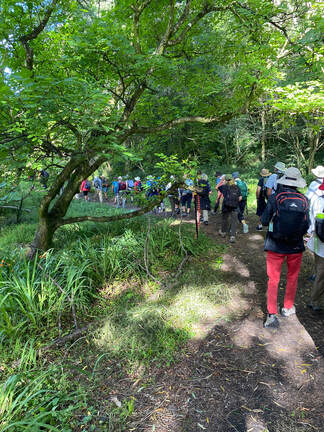
It was a cool, calm morning as 36 of us set off from the Hooton Reserve Carpark in Albany to explore the surrounding area and learn some of the history of this now busy northern suburb of Auckland. The reserve is accessed from Mills Lane which runs off Oteha Valley Road. Hundreds of motorists pass it by each day but the locals and their dogs walk the bush tracks and must enjoy having this slice of nature so close to home.
As we carefully followed the Lucas Creek track, which had suffered some damage in last year’s storms, we saw or heard grey warblers, fantails, magpies, pukeko and tui among the native rimu, totara, matapo, puriri and kahikitea.
We crossed the road at the Lucas Creek Bridge then set off on the left hand side of the creek,which runs along the edge of Gills Scenic Reserve. We followed Lucas Creek, past the crossing where a bridge once existed and where the bullock teams serviced the local abattoir and on to a pretty waterfall which was a popular spot for family picnics.
Another busy road crossing at Dairy Flat Highway, past the old Albany Pub took us to the Phillips Property whose family butchery and bakery supplied the local workers, especially the gum diggers. The Albany area used to be full of orchards and in 1889 the first consignment of apples and pears was exported to the UK, sourced from both Greenhithe and Albany. The big wooden chair, carved by inmates at nearby Paremoremo prison is a feature in Kell Park where we had morning tea.
|
Flax was another of the products which came out of this area in large quantities. In Kell Park there is a statue of Daniel Lucas, one of the original traders. Along this stretch of the creek is the Upper Landing where the ships would come up on the high tide and load up flax, gum, wool and kauri to be taken to Auckland and further afield. The Lower Landing which was further on our walk at Wharf Reserve was another loading area for exports from the area.
|
Then we crossed the Albany Highway and headed onto the track along Oteha Valley Stream, looking across to the Fernhill Escarpment. The escarpment track with its well built boardwalks was badly damaged in the storm last year and is currently closed for safety reasons but the alternative one was not difficult - just a bit more basic. There was little birdlife observed (except for happy ducks) but the giant totaras are impressive among the rimu, kahikatea, native ferns, hoheria and supplejack. The succession of waterfalls is quite beautiful so we chose this area to stop for lunch near Hugh's Seat, a seat dedicated to the late Hugh Willis QSM, long serving science teacher at Westlake Boy's High who created 10kms of bush tracks through Albany. It was good to see that some repairs have begun to the storm damage.
We then made our way up the Bush Road hill to the Albany Expressway to admire the beautiful Innovation Building at Massey University Campus. Donated trees line the roadside along its frontage, including karaka and puriri. Finally back at North Harbour Stadium and the Albany shopping precinct (which originally was the Hooten Dairy Farm} having completed a full circle of an area once a major source of primary produce and now a busy suburb.
Fiona & Cristy, today's leaders, had obviously put a lot of effort into researching this walk. Many thanks to you both.
Thanks also to the recce helpers - Sandra W. & Jan.
Text: Sandra W. Photos: Linda
Thanks also to the recce helpers - Sandra W. & Jan.
Text: Sandra W. Photos: Linda
21 January 2024 - Helensville and Kaipara Coast
We had an unusually large number of walkers sign up for this first outing of 2024. 45 enrolled and 43 walked on the day. The trip consisted of four distinct parts:
1) HELENSVILLE.
After a pleasant drive from Auckland via Kumeu, we were dropped off beside the public toilet block in Helensville’s Main Street. These toilets are famous, as they were designed and built by well-known local artist, Jeff Thompson, out of corrugated iron of course. After trying out the loos, which were the new automated variety, we gathered on a nearby viewing deck beside the muddy brown Kaipara River, where several dragon boats were training.
Here we heard a history of the area in 3 phases - first, kauri timber milling; second, dairy farming and tourism based on the thermal pools at Parakai; and third, as a tourist destination, close to Auckland, with various attractions and proximity to the Kaipara Harbour. We also learned the origin of the English name for the town - pioneer timber miller John McLeod was one of the first settlers to come here and he built a sturdy kauri villa for his wife, Helen. This house became known as Helen’s Villa, and that eventually morphed into the name Helensville.
After a pleasant drive from Auckland via Kumeu, we were dropped off beside the public toilet block in Helensville’s Main Street. These toilets are famous, as they were designed and built by well-known local artist, Jeff Thompson, out of corrugated iron of course. After trying out the loos, which were the new automated variety, we gathered on a nearby viewing deck beside the muddy brown Kaipara River, where several dragon boats were training.
Here we heard a history of the area in 3 phases - first, kauri timber milling; second, dairy farming and tourism based on the thermal pools at Parakai; and third, as a tourist destination, close to Auckland, with various attractions and proximity to the Kaipara Harbour. We also learned the origin of the English name for the town - pioneer timber miller John McLeod was one of the first settlers to come here and he built a sturdy kauri villa for his wife, Helen. This house became known as Helen’s Villa, and that eventually morphed into the name Helensville.
We then set off on the Riverside Walk which led us along between the river and the railway line for about a kilometre. By that stage we could see the Helensville wharves up ahead of us, with several old fishing boats tied up alongside. Our path led us onto the main road and, after a short distance, to the Helensville Museum.
At the Museum, we were met by several of the volunteers, who had kindly opened the museum for our group (they normally close on Sundays) and then ushered us around the collection of old houses, a barn, a courthouse and a schoolhouse. All these buildings had the appropriate furniture and contents and were fascinating to see. Lots of items sparked memories amongst some members of our group. The contents of the barn confirmed the history we had learned about the area, as there was machinery and equipment to do with the kauri milling and kauri gum industries and early dairy farming, along with lots of everyday items from that time as well.
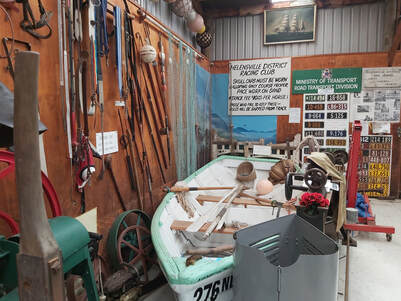
There was an old rowboat in the back corner of the barn, with photos and a story on the wall behind about a very courageous lady who made a living from fishing, becoming NZ’s first woman commercial fisher. Her name was Flora Thirkettle, she lost her husband and had to support 7 young children on her own. She only knew farming and fishing, and as she didn’t have a farm she decided to go fishing on the Kaipara Harbour, often taking several of her children out in the boat with her. To start with, she was everyone’s enemy - the men thought she had no right to be doing a “man’s job” and the women thought she had no right to be out on the water with “their men”. However, in time she proved herself to be a good fisherwoman, in spite of her small stature and having to also look after her young children. She was adept at making and mending fishing nets and later at fixing motors, and was happy to help others with both these tasks. There were a couple of incidences when she had to rescue some of the men who were in strife on the water, so she eventually won people’s admiration. In fact, she became known as the Queen of the Kaipara, and only passed away a few year’s ago, in her 90’s. A story of real courage and an example of the tough pioneering spirit in this area in days gone by!!
2) We drove through Helensville, past some historical old buildings like the Grand Central Hotel, opposite the old Railway Station, to the A & P Showgrounds, to spend an hour at the Kaukapakapa Village Market. This was an interesting group of stallholders selling arts and crafts, household goods, plants, lovely bouquets of wildflowers, clothing, jewellery, coffee and food. There was something for everyone and obvious to see that this is a region of lots of creativity.
3) Off on the bus again, to the Kaipara Coast Highway, to visit Omeru Reserve with it’s bush tracks to two waterfalls - the Omeru Falls and the Waitangi Falls. We divided into two groups to make it a bit faster and each group went to a different waterfall.
Back on the bus, we had a little quiz about the trees that were spotted - it took our minds off the afternoon heat, which was pretty oppressive. We were able to list quite a few trees - totara, rimu, pittosporum, kowhai, nikau, cabbage tree, manuka, kanuka, and the biggest of them all, kauri. It was good to know that people hadn’t had their heads down watching the scoria path all the time!
Back on the bus, we had a little quiz about the trees that were spotted - it took our minds off the afternoon heat, which was pretty oppressive. We were able to list quite a few trees - totara, rimu, pittosporum, kowhai, nikau, cabbage tree, manuka, kanuka, and the biggest of them all, kauri. It was good to know that people hadn’t had their heads down watching the scoria path all the time!
|
4) Our final stop for the day was the Kaipara Coast Sculpture Garden, where we spent about 1 1/4 hours walking through the beautiful ’secret’ garden, admiring the range of outdoor art scattered about. In all, the garden has 40 pieces, the variety was huge - and so were some of the prices! Back on the bus for the last time and we headed home via Kaukapakapa, Silverdale and SH1. An interesting day as we eased our way back into action after the holidays. Special thanks to today's leaders, Sandra and Ann Marie who obviously put a lot of research into this trip. Also their helpers on the day, Josephine and Cristy. Text: Sandra Photos: Sue & Linda. |
